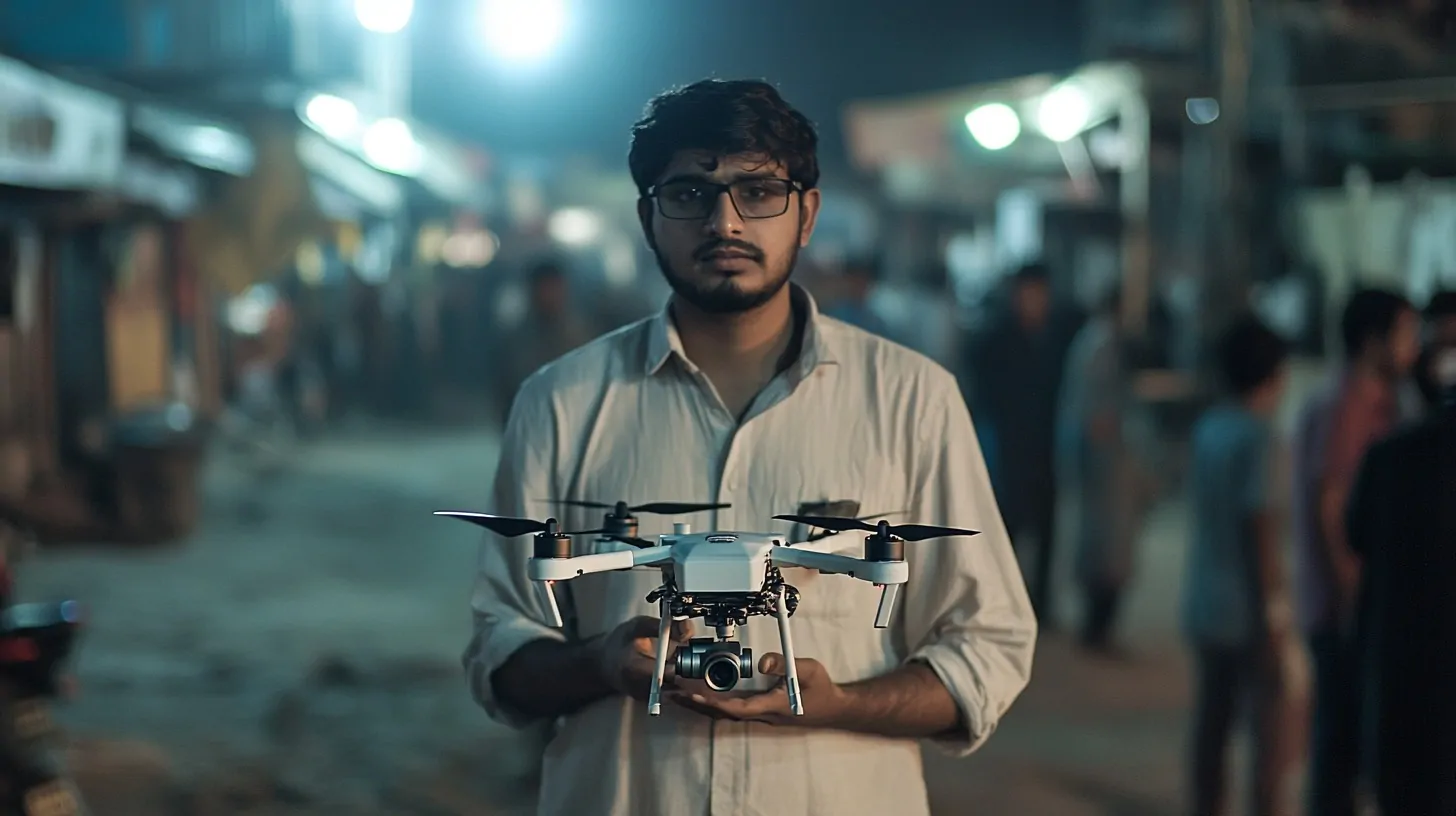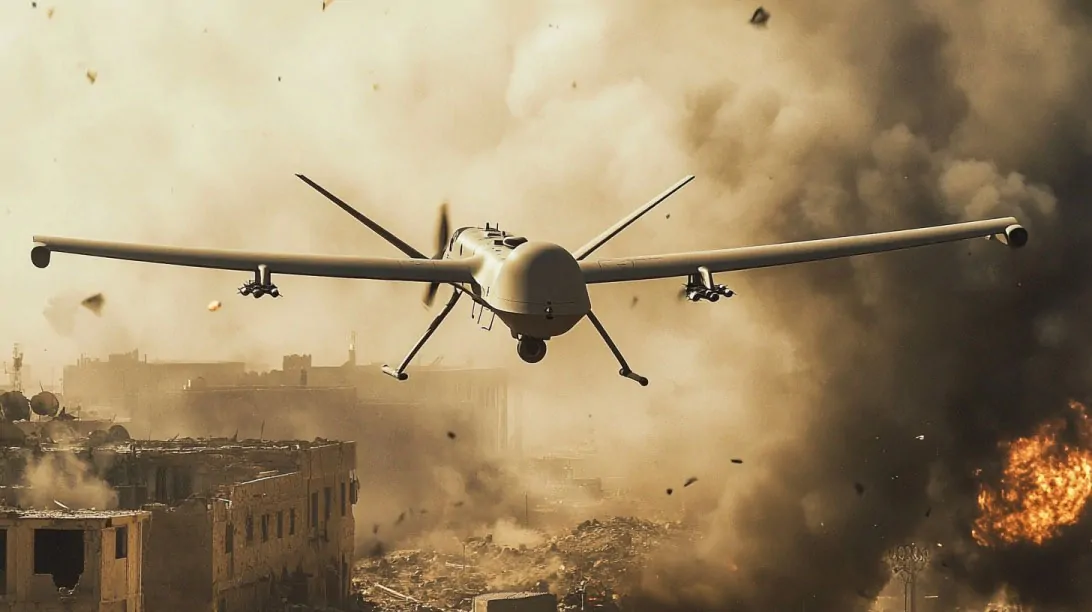Rising tensions in early 2025 reignited the India-Pakistan conflict after a deadly militant strike in Kashmir. Ceasefires were immediately undermined by high-tech drone and missile exchanges, marking a shift in regional warfare.
Both countries began relying less on manned air combat and more on unmanned systems to assert military dominance.
Combat strategy rapidly evolved, with drones taking center stage for surveillance, targeting, and offensive strikes. After the Nagorno-Karabakh and the Russia-Ukraine war, drone warfare played a decisive role in shaping direct engagements between two nuclear-armed neighbors.
Escalation in drone usage signaled a transformation in how future military confrontations in South Asia may unfold.
That is why we believe it is important to know about the India-Pakistan conflict and how the two sides use drones to gain the upper hand.
Table of Contents
ToggleIndia’s Drone Strategy and Capabilities

Indian defense planners made a decisive shift in strategy following high-profile aerial combat losses during past confrontations. In response, the military turned to Israeli-origin drones, particularly the Harop loitering munition.
Designed to hover over target areas and strike with precision, these drones eliminated the need to place pilots in high-risk situations.
Adoption of Harop systems represented a calculated response to modern air defense threats. Drone warfare offered operational freedom in heavily contested airspaces, allowing for deep-penetration missions and real-time adjustments based on enemy movements.
- Ability to strike high-value targets with minimal warning.
- Elimination of pilot risk in forward areas.
- Reduced response time for cross-border engagements.
- Operational flexibility in mountainous and high-altitude zones.
Rather than relying exclusively on conventional manned squadrons, India recalibrated its approach. Drones became a front-line tool in tactical planning. Israeli support filled an immediate capability gap while India worked on its domestic production.
Integration into Military Doctrine
Domestically, the Harop drone was rebranded as the P-4 system and folded into India’s defense production ecosystem.
Indian military leadership placed growing emphasis on drone-centric operations in environments where radar jamming, missile defense, and anti-air batteries were active threats.
- Promoting drone autonomy for rapid-response missions.
- Using drones to map and neutralize enemy SAM (surface-to-air missile) sites.
- Enhancing reconnaissance capabilities in denied zones.
- Minimizing reliance on foreign technology by integrating domestic upgrades.
Adopting a drone-first model allowed Indian forces to challenge adversaries without exposing human pilots. Integrating these platforms into command networks also allowed real-time data sharing between intelligence units and frontline commanders.
P-4 drones bridged the gap between imported solutions and indigenous innovation.
Limitations and Countermeasures
Despite tactical advantages, drone deployments exposed structural weaknesses. Around 25 Harop drones were shot down by Pakistani air defenses, undermining their image as invulnerable assets. Each downing represented not just a hardware loss but a potential breach in electronic security.
Speculation also circulated regarding backchannel leaks in drone-related technologies. Azerbaijan’s use of similar drones in the Nagorno-Karabakh conflict, coupled with regional partnerships, raised concerns about adversaries gaining access to drone countermeasures.
- Susceptibility to electronic jamming and GPS spoofing.
- Potential for enemy data extraction after drone retrieval.
- Overreliance on foreign-supplied components.
- Limited endurance during long-haul missions without satellite links.
Awareness of these shortcomings sparked increased investment in hardened systems and anti-jamming protocols. Defense scientists and private firms focused on boosting the survivability of drones through stealth coatings, enhanced signal encryption, and multi-mode targeting systems.
Pakistan’s Drone Strategy and Superiority
Pakistan embraced an aggressive and calculated swarm drone strategy during the 2025 escalation. Between 400 and 500 drones were launched in synchronized waves, designed not just to strike but to confuse, deceive, and analyze.
These operations served a dual purpose, testing the effectiveness of India’s air defense systems while simultaneously collecting intelligence crucial for orchestrating follow-up missile strikes.
Use of such overwhelming drone numbers ensured India’s radar and electronic defense assets were pushed to their limits. By forcing India to reveal its detection patterns and interception capabilities, Pakistan created a tactical blueprint for future high-impact strikes.
- Decoy drones to saturate radar and mislead defense systems.
- SIGINT/ELINT drones to gather information on Indian electronic emissions and frequencies.
- Combat-capable drones capable of target acquisition and destruction during swarm confusion.
Domestic Manufacturing and Technological Base
Pakistan’s drone expansion was not confined to acquisition but was deeply rooted in local production and technological collaboration. Strategic partnerships with Turkey and China resulted in the rapid development and deployment of drone systems tailored to regional warfare demands.
Platforms such as Burraq, Shahpar-II, Bayraktar TB2, and Sarfirosh were central to operations, combining surveillance, targeting, and strike capabilities.
National agencies, particularly NESCOM (National Engineering and Scientific Commission), GIDS (Global Industrial & Defence Solutions), and Pakistan Aeronautical Complex (PAC), spearheaded local drone development.
Their role encompassed everything from research and design to final production and battlefield deployment.
Operational Effectiveness
Did this Indian drone really get intercepted in Pakistan❓
⚠️Pakistan-based handles are sharing an old image claiming that the Pakistan Army has intercepted a UAV drone that fell in Gujranwala, Pakistan.
✅ The image being circulated is from the Ukraine-Russia conflict in… pic.twitter.com/m04rGSbQsu
— All India Radio News (@airnewsalerts) May 8, 2025
In execution, Pakistan’s drone program demonstrated more than theoretical strength. Multiple drones reportedly penetrated Indian airspace, reaching high-value targets that disrupted command infrastructure and fuel depots.
Each successful strike carried strategic weight, delivering not just physical damage but psychological pressure on Indian forces and political leadership.
India publicly denied the severity of these intrusions, but open-source satellite imagery and local reporting hinted at a tangible impact. Pakistan, meanwhile, celebrated the results as proof of its expanding technological edge and operational discipline.
- Coordination across air, cyber, and electronic domains, ensuring each drone wave functioned within a broader strategic plan.
- Minimal collateral damage, attributed to precise targeting and real-time strike adjustments.
- Rapid launch-to-impact cycle, reducing enemy reaction time.
Tactical momentum briefly favored Pakistan during this period, raising alarms within Indian strategic circles. For a conflict often framed in conventional terms, Pakistan’s drone dominance introduced a disruptive force multiplier with real battlefield consequences.
India’s Counter-Drone Measures
Drones used by Pakistan during the 2025 escalation presented a significant challenge for Indian defenses. Frequent incursions into Indian airspace, combined with the threat of swarm tactics and kamikaze strikes, demanded a robust and adaptable response.
Indian defense strategists prioritized rapid deployment of indigenous systems capable of identifying, tracking, and neutralizing these threats. Central to this response was the D4 “Detect, Deter, Destroy” system.
Israeli kamikaze drones take center stage in India-Pakistan conflicthttps://t.co/bWiQrLTWty
— Haaretz.com (@haaretzcom) May 10, 2025
D4 “Detect, Deter, Destroy” System
Developed by DRDO, the D4 system represents India’s comprehensive response to aerial threats posed by unmanned systems. Designed to secure both fixed and mobile assets, it combines electronic warfare techniques with physical destruction tools.
The system uses a combination of detection technologies and engagement options tailored for a variety of drone types.
- 360° Surveillance Coverage: Ensures no blind spots across high-risk areas.
- RF and GNSS Jamming: Disrupts communication and navigation between enemy operators and their drones.
- GPS Spoofing Capability: Confuses drone navigation systems, forcing them to lose course or land prematurely.
- Laser-Based Hard-Kill Solution: Physically disables drones using high-energy laser beams.
- Modular Architecture: Allows for easy integration on vehicles, rooftops, or field installations depending on mission needs.
- AI-Assisted Tracking: Provides real-time targeting solutions based on drone behavior patterns and environmental data.
Adaptability made the D4 system suitable for protecting both static infrastructure and forward-operating bases.
Its lightweight deployment options allowed Indian forces to establish drone defenses quickly across sensitive zones, particularly in areas like Jammu and Punjab, where drone penetration was most frequent.
Operational Success
D4 proved to be more than just a deterrent; its operational record during high-alert periods reflected consistent performance in live combat scenarios. Pakistani drones targeting military bases and civilian installations were intercepted before completing missions.
Reports indicated that key drone formations, especially those intended for swarm interference or reconnaissance, were neutralized in real-time.
- Jammu Sector: High-altitude installations reported nearly 85% interception rate over a 48-hour drone assault period.
- Punjab Border Zones: Forward units noted a complete suppression of a small swarm attack through coordinated jamming and directed energy response.
- Critical Infrastructure Protection: Key sites including air bases and radar stations remained uncompromised during peak drone activity.
Real-time telemetry and data-sharing between D4 units enhanced battlefield awareness. AI systems running pattern recognition modules helped Indian command identify evolving tactics and adapt faster than traditional command cycles allowed.
Mutual Accusations and Civilian Impact
India accused Pakistan of using drones to attack religious structures and civilian zones. Pakistan denied the allegations, countering with claims of Indian misinformation campaigns. In affected regions like Jammu, Punjab, and Karachi, civilian fear spiked as air sirens and explosions became routine.
Psychological impacts were severe. Families fled border towns, schools shut down, and economic activities slowed. In the fog of war, disinformation spread rapidly through local media, fueling nationalistic sentiments and diminishing trust in official narratives.
Social media played a significant role in amplifying both accurate updates and fabricated claims. Narrative warfare emerged as a critical front, shaping public opinion as much as battlefield realities.
Final Thoughts
Drones reshaped the India-Pakistan conflict into a contest of electronic warfare, swarm tactics, and autonomous weapons. Rapid deployment, tactical anonymity, and reduced pilot risk created asymmetric advantages for both nations.
More than tools of destruction, drones served psychological functions—projecting power, disrupting morale, and igniting fear. In the India-Pakistan conflict, where escalation risks remain existential, drones accelerated confrontation timelines.
Urgent dialogue among regional powers and global stakeholders is needed. Without frameworks to manage drone warfare, future skirmishes may spiral faster than diplomacy can respond.
Related Posts:
- The Role of Underwater Drones in Modern Naval Warfare
- The Role of FPV Drones in Tactical Military Applications
- Eyes in the Sky - The Role of a Military Satellite…
- The Role of 5G in Modern Military Operations
- The Real Story of Drones Spotted Over US Bases
- Unmanned Aerial Vehicles - Types of Military Drones…







